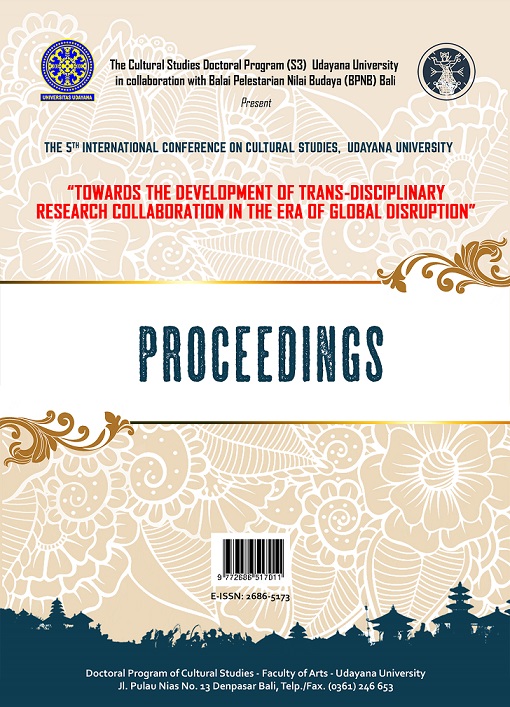“MURAL” AS A RESISTANCE MEDIA FOR ENVIRONMENT POLLUTION IN DENPASAR
Abstract
“Mural” is from the word "Murus"(Latin) which means wall. Broadly speaking, the definition of “mural” is drawing or painting on wall, wall or other broad media that is permanent. Murals can usually be found on outdoor walls, especially those facing or can be seen from the road. The development of mural art in Denpasar is quite good, this is inseparable from the support of the local government. The Denpasar of Government encourages villages to innovate by developing creative arts in the environment.Mural art is expected to be a place of creativity for artists and young people to add to the beauty of the surrounding environment. Making the mural was facilitated by villages in Denpasar.In addition, mural arts are expected to become a new source of income and empower the surrounding communities that are managed to become new tourist destinations in the middle of the city. Aside from being a means to beautify the face of the city, murals also become one of the aspirational media, especially those that contain social criticism, anxiety, and disappointment expressed by artists/local communities, such as some mural arts created around the Badung Market - Denpasar.The murals were made by emphasizing the protest message about the increasing environmental pollution in Denpasar. The message he delivered also looked unique by displaying a figure of a dancer or Balinese person who uses a nose mask, so that it is very easy for people to digest.This is in line with Marxist aesthetics which say that works of art can be very dependent on the environment, both in terms of content and form. The closeness of mural art to the public was used as a medium of resistance in the hope that the issues of environmental pollution raised could reach the people who saw the mural.
Downloads
References
Candra, Ni Made Tanti, Wahyu Budi Nugroho, I Nengah Punia. 2017. “Dalam jurnal: Fakultas Ilmu Sosial dan Ilmu Politik”, Universitas Udayana.
Fitri, Meila Riskia. 2015. “Mural sebagai Medium Kritik Sosial Seniman” (Studi Kasus “Jogja Asat”), Tesis, Fakultas Ilmu Sosial Dan Ilmu Politik Universitas Gadjah Mada.
Hall, Stuart. 1998. “The Work of representation, dalam Representation: Cultural Representations and signifying Practises”, Sage Publication, Ltd., London.
Lafebvre, Henri. (1991). The Production of Space, diterjemahkan oleh DonaldNicholson-Smith. Brasil Blackwel.Oxford.
Setiawan, A. (2016). Produksi Ruang Sosial Sebagai Konsep Pengembangan Ruang Perkotaan (Kajian atas Teori Ruang Henri Lafebvre). Haluan Sastra Budaya, 33(66), 44-52.





